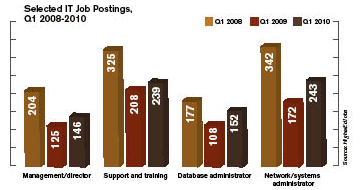Seek and Ye May Find
An increase in higher ed IT job postings may be good news for job seekers.

While most IT-related jobs from Q1 2009 to Q1 2010 saw a postings increase, database administrators and network/systems admins saw a considerable jump in advertised positions (40% and 41%, respectively). Network/systems admin job advertisements, however, were still down 29% from their Q1 2008 postings, while database admin jobs were only 14% off their Q1 2008 highs. Managerial/director and support/training job ads increased only 17% and 15%, respectively, during the same period, and were 28% and 26% lower than their Q1 2008 numbers.
HigherEdJobs announced in May that advertisements for job openings were “up dramatically” in the first quarter 2010 over first quarter postings from 2009.
According to John Ikenberry, president on the online company, postings across all higher ed job categories on the HigherEdJobs site were up 42 percent for the first quarter of 2010 versus the first quarter of 2009. These numbers represent advertisements from higher ed institutions and, to a lesser extent, from companies that do business in higher ed.
The story for computer and IT job postings was also good news. There was a 34 percent increase in advertisements for all IT-related jobs between Q1 2009 and Q1 2010. Most individual job categories within IT also experienced a postings spike, in some cases 40 percent or higher.
However, the number of Q1 2010 IT jobs listed was still lower than in Q1 2008. Ikenberry acknowledges that “demand is not back to prerecession levels,” adding, “That mirrors what we are seeing at the national level across all of higher education.”
The numbers may not return to the 2008 peak for some time, Ikenberry cautions. He is also careful to point out that some of the jump in the number of postings may be attributed to an increase in the number of schools that are using HigherEdJobs to post their available slots.
But for job seekers, “that distinction is probably unimportant, since people can only apply for jobs they are aware of,” says Ikenberry. “And the universe of what they can apply for in this area of academia has certainly increased.”
For information on the report, go to higheredjobs.com/career/quarterly-report.cfm?q=1&y=2010.